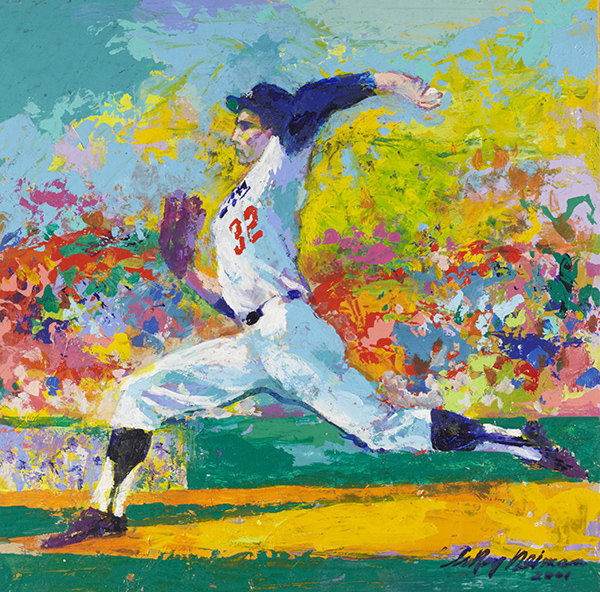Best known for his brilliantly colored, stunningly energetic images of sporting events and leisure activities, LeRoy Neiman was one of the most popular living artists in the U.S. before his passing in 2012.
Now, with the assistance of the The LeRoy Neiman Foundation, a significant collection of his works will be part of an exhibition for the first time in Ohio from Jan. 22 — April 14, 2018 at Muskingum University.

Exhibition Dates
Monday, Jan. 22, 2018 — Saturday, April 14, 2018
Exhibition Location
Louis O. Palmer Gallery and
Philip & Betsey Caldwell Hall
Muskingum University
163 Stormont Street
New Concord, OH 43762
Parking at Caldwell Hall:
From Main St., turn on Comin St. (left if traveling east, right if traveling west). Turn right at the first parking lot entrance. Park at the top tier of the parking lot. Caldwell Hall is the building on the right.
Parking at the Palmer Gallery:
From Main St., turn on College Dr. (left if traveling east, right if traveling west). Turn right on High St. At the New Concord United Methodist Church, turn left into the parking lot. Turn left at the Neptune Center. Parking spots are available on the right. The Palmer Gallery is the building on the left.
Exhibition Hours
| Sunday | Closed |
| Monday | 9:30 a.m. - 3:30 p.m. |
| Tuesday | 9:30 a.m. - 3:30 p.m. |
| Wednesday | 9:30 a.m. - 3:30 p.m. |
| Thursday | 9:30 a.m. - 8:30 p.m. |
| Friday | 9:30 a.m. - 3:30 p.m. |
| Saturday | 1:00 p.m. - 4:00 p.m. |
Special Events
"American Expressionism" Concert
Pre-Concert Lecture: 7:00 p.m. | Concert: 7:30 p.m.
Friday, March 16, 2018
Philip & Betsey Caldwell Hall's
Sandra Wolfe Thompson Theatre
An Original Devised Theatre Performance
8:00 p.m., Thursday, April 12, 2018
2:00 p.m. & 8:00 p.m., Saturday, April 14, 2018
Philip & Betsey Caldwell Hall's
Sandra Wolfe Thompson Theatre
About LeRoy Neiman
Artist LeRoy Neiman was best known for illustrations that presented scenes of sports and entertainment and the people that brought those pastimes to life. Like the America of his times, from the start of his professional art career in the 1950s until his death in 2012, Neiman grew wealthy. Neiman, a child of the Great Depression, was frugal. Yet in one of his many paradoxes, he was enormously generous. In his later years, he established the LeRoy Neiman Foundation and donated nearly $20 million – a perhaps unprecedented amount for a living artist – to art institutions as well as to programs that helped disadvantaged young artists around the United States. Neiman he knew where he had come from and how he got to where he was, and he gave back.
In terms of Neiman’s place in American art, he was 27 years younger than Norman Rockwell (1894-1978) and seven years older than Andy Warhol (1928-1987). Rockwell came of age in an era when magazines were the most common national media in the country, and he proudly considered himself an illustrator rather than artist. In a style that honored the realism of the late-19th and early 20th centuries, Rockwell depicted telling and heart-warming moments from American small-town life. Warhol helped create a new genre of art that turned the common and the extraordinary in American culture – from soup cans to movie stars – into icons.
Neiman worked both as an illustrator and as an artist whose paintings, prints, and drawings were shown in galleries and reproduced in numerous publications. He created illustrations for Playboy, Sports Illustrated, Harpers and dozens of other magazines, and exhibited his works at the Hammer Galleries in New York and the Franklin Bowles Gallery in San Francisco.
Neiman took the subjects of photographers, cartoonists, and 19th century engravers and brought them to 20th century life. He used a palette knife to create lush, textured, and his often unmixed colors – vibrant to some, ostentatious to others – made his canvases hum with energy. He fused techniques of 1940s and 1950s action painting pioneered by Willem de Kooning and to the art of illustration and added elements of Impressionism and Expressionism. His distinctive body of work and style chronicled American life as the country came into an era of affluence. And his art appealed to people far beyond the walls of museums and avant garde galleries: it captured the attention and affection of people who were impassioned players in the American dream of toil, sweat, and success.
Contact
For more information, call 740-826-8095 or 740-826-8102 or email neiman@muskingum.edu.